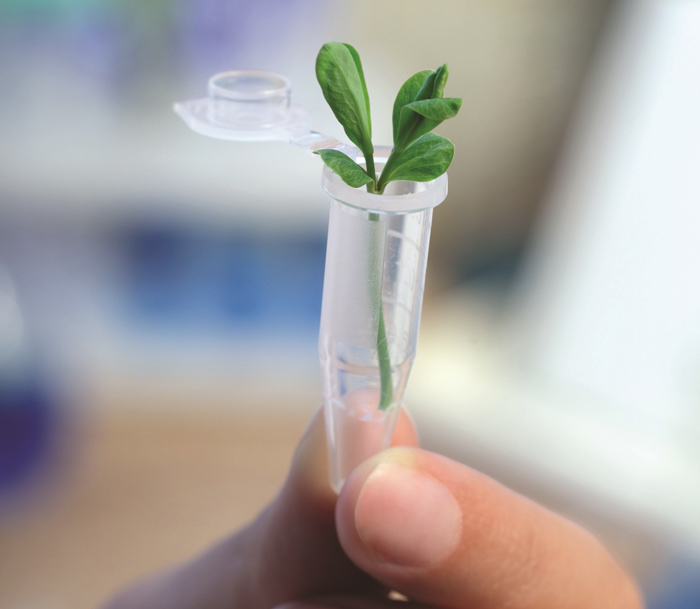Just imagine a world where we lived in perfect harmony with nature – no human suffering, farmers sustainably producing enough food that is safe and affordable, limited threats from pest and disease pressure, no excessive use of agricultural inputs such as insecticides, herbicides and fertilisers, and coexistence in an environment that positively copes with the needs of human activities. While achieving this type of utopia may sound unreal, rapidly evolving technologies on the horizon may well make this future dream a reality, sooner than we think.
One of these technological breakthroughs is known as CRISPR (clustered regularly interspaced short palindromic repeat). While it is still regarded as a new addition to the breeding toolkit, improvements in its functionality and versatility have boosted its use in the breeding of new crops. Cheaper and far more precise than previous gene-editing processes, the CRISPR toolkit continues to advance applications that unlock the natural ability of plants to deliver even more benefits. Let us uncover how CRISPR is being explored in plants to ensure that agriculture’s future is more sustainable.
Enhancing nitrogen in the soil
Nitrogen is an essential component for plant growth, which is why producers rely on fertilisers to maximise their yield. However, over-fertilisation is considered one of the main reasons for increased levels of nitrogen compounds in soil which are harmful to the environment and climate. Through the successful application of CRISPR tools, researchers have been able to engineer rice that promotes soil bacteria to fix nitrogen from the air. But how is this even possible?
Through an understanding of the genomics and chemical pathways involved in nitrogen uptake in rice, CRISPR technologies were used to make precise tweaks in the native genome of rice to upregulate the production of chemicals that trigger the increased activity of nitrogen-fixing soil bacteria. Enhancing the nitrogen conversion processes by bacteria increased the availability of ammonium for uptake by plants without any compromise in yield. By reducing the need for inorganic nitrogen fertiliser and allowing plants to thrive in nitrogen-poor soils, this discovery helps move agriculture one step closer to reducing its emissions footprint.
Maximising carbon capture
Plants in particular, are one of the best tools we have to capture carbon dioxide from the air through photosynthesis. Eventually half of the carbon captured by plants ends up in roots and soil where it can be stored for a very long time. Scientists have recently embarked on an ambitious goal to harness the natural ability of plants to capture carbon. By using CRISPR tools, researchers are making small precise genetic edits in rice plants to maximise the efficiency of photosynthesis, generating plants that capture up to 30% more atmospheric carbon in their tissues. But it doesn’t end here. Carbon sequestration efforts are also targeting carbon storage below ground. By screening and identifying rice and sorghum crop varieties with existing beneficial root systems, research is under way to use CRISPR editing to develop more extensive and deeper root systems to effectively capture more carbon for longer storage below the ground.
 Reducing water use
Reducing water use
Equipped with a deep understanding of how photosynthesis works, scientists have successfully edited a single gene in tobacco that tricks the plants into closing tiny pores (stomata) on the surface of its leaves to minimise water loss. The end result is tobacco plants with up to 25% better water use efficiency, meaning less water absorption from the soil. This demonstrated success opens up opportunities to design important food crops such as maize and soybean with novel water-efficient traits, enabling them to thrive during prolonged conditions of water scarcity.
Optimising yield gains
To avoid further encroachment on biodiversity and protected environments requires the finding of better ways to optimise crop yields on existing agricultural land. This is no easy feat as breeding for yield gains in various staple food crops is a rather complex process. Recent discoveries, however, have identified a yield-enhancing gene in wheat. Through a series of genetic evaluations scientists have been able to pinpoint the genes specifically involved in regulating the number of spikelets in wheat. With CRISPR-based editing of the targeted wheat gene, significant improvements in wheat grain yield were observed. Considering the global importance of wheat as a food staple, these genetic improvements in yield gain have positive implications not just for food security, but also for improving agricultural productivity and efficiency without the need for more land.
Securing a future for our planet through sustainable agriculture
Genome editing tools such as CRISPR will have an important role to play in positively transforming the sustainability footprint of agriculture. Ensuring sustainability in agriculture under worsening conditions due to climate impacts and deteriorating natural resources, places a huge responsibility on producers. The widespread application of CRISPR tools promises to deliver an array of ground-breaking discoveries in plants, capitalising on the beneficial traits and characteristics that plants already display. While agriculture and our planet face many challenges, we have no choice but to embrace the opportunities offered by new technologies to ensure that crops designed to be more nitrogen-efficient, water-efficient, carbon-hungry and higher-yielding, become a reality rather than a dream deferred.

















